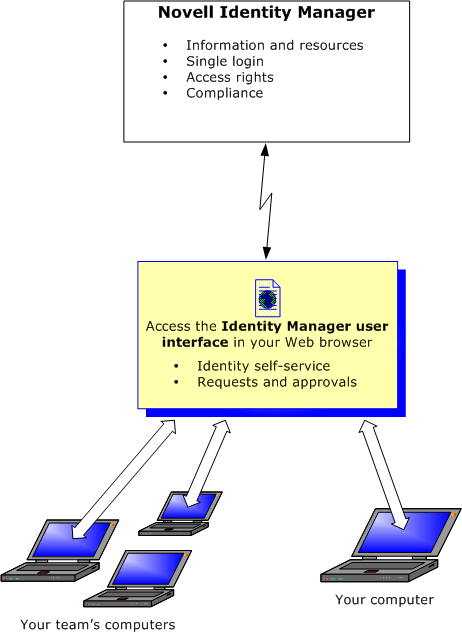1.1 Identity Manager and you
Novell Identity Manager is a system software product that your organization uses to securely manage the access needs of its user community. If you’re a member of that user community, you benefit from Identity Manager in a number of ways. For example, Identity Manager enables your organization to:
-
Give users access to the information (such as group org charts, department white pages, or employee lookup) and resources (such as equipment or accounts on internal systems) that they need, right from day one
-
Synchronize multiple passwords into a single login for all your systems
-
Modify or revoke access rights instantly when necessary (such as when someone transfers to a different group or leaves the organization)
-
Support compliance with government regulations
To bring these benefits directly to you and your team, Identity Manager provides a user interface that you can use from your Web browser.
1.1.1 Introducing the Identity Manager user interface
The Identity Manager user interface is your view into the information, resources, and capabilities of Identity Manager. Your system administrator determines the details of what you can see and do in the Identity Manager user interface. Typically, this includes:
-
Identity self-service, which enables you to:
-
Display organization charts
-
Edit the information in your profile
-
Search a directory
-
Change your password
-
Create accounts for new users (if you are authorized)
-
-
Requests and approvals, which enable you to:
-
Issue requests for resources
-
Check on the approval of your resource requests
-
Work on tasks assigned to you for approving other resource requests
-
Perform requests and approvals as a proxy or delegate for someone else
-
Assign someone else to be your proxy or delegate (if you are authorized)
-
Manage all of these request and approval features for your team (if you are authorized)
NOTE:Requests and approvals require the Provisioning Module for Identity Manager.
-
1.1.2 The big picture

1.1.3 Typical uses
Here are some examples of how people typically use the Identity Manager user interface within an organization.
Working with identity self-service
-
Ella (an end-user) recovers her forgotten password through the identity self-service features when logging in.
-
Erik (an end-user) performs a search for all employees at his location who speak German.
-
Eduardo (an end-user) browses the organization chart, finds Ella, and clicks the e-mail icon to send a message to her.
Working with requests and approvals
-
Ernie (an end-user) browses a list of resources available to him, and requests access to the Siebel system.
-
Amy (an approver) receives notification of an approval request via e-mail (which contains an URL). She clicks the link, is presented with an approval form, and approves it.
-
Ernie checks on the status of his previous request for Siebel access (which has now gone to a second person for approval). He sees that it is still in progress.
-
Amy is going on vacation, so she indicates that she is temporarily unavailable; no new approval tasks will be assigned to her.
-
Amy opens her approval task list, sees that there are too many for her to respond to in a timely manner, and so reassigns several to co-workers.
-
Pat (an administrative assistant, acting as a proxy user for Amy) opens Amy’s task list and performs an approval task for her.
-
Max (a manager) views the task lists of people in his department. He knows that Amy is on vacation, so he reassigns tasks to others in his department.
-
Max initiates a request for a database account for someone in his department who reports directly to him.
-
Max assigns Dan to be an authorized delegate for Amy.
-
Dan (now a delegated approver) receives Amy’s tasks when she is unavailable.
-
Max engages an unpaid intern, who should not be entered into the HR system. The system administrator creates the user record for this intern and requests that he be given access to Notes, Active Directory, and Oracle.